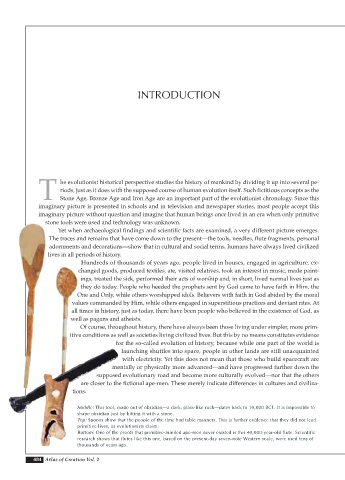Page 486 - Atlas of Creation Volume 2
P. 486
INTRODUCTION
he evolutionist historical perspective studies the history of mankind by dividing it up into several pe-
riods, just as it does with the supposed course of human evolution itself. Such fictitious concepts as the
T Stone Age, Bronze Age and Iron Age are an important part of the evolutionist chronology. Since this
imaginary picture is presented in schools and in television and newspaper stories, most people accept this
imaginary picture without question and imagine that human beings once lived in an era when only primitive
stone tools were used and technology was unknown.
Yet when archaeological findings and scientific facts are examined, a very different picture emerges.
The traces and remains that have come down to the present—the tools, needles, flute fragments, personal
adornments and decorations—show that in cultural and social terms, humans have always lived civilized
lives in all periods of history.
Hundreds of thousands of years ago, people lived in houses, engaged in agriculture, ex-
changed goods, produced textiles, ate, visited relatives, took an interest in music, made paint-
ings, treated the sick, performed their acts of worship and, in short, lived normal lives just as
they do today. People who heeded the prophets sent by God came to have faith in Him, the
One and Only, while others worshipped idols. Believers with faith in God abided by the moral
values commanded by Him, while others engaged in superstitious practices and deviant rites. At
all times in history, just as today, there have been people who believed in the existence of God, as
well as pagans and atheists.
Of course, throughout history, there have always been those living under simpler, more prim-
itive conditions as well as societies living civilized lives. But this by no means constitutes evidence
for the so-called evolution of history, because while one part of the world is
launching shuttles into space, people in other lands are still unacquainted
with electricity. Yet this does not mean that those who build spacecraft are
mentally or physically more advanced—and have progressed further down the
supposed evolutionary road and become more culturally evolved—nor that the others
are closer to the fictional ape-men. These merely indicate differences in cultures and civiliza-
tions.
Middle: This tool, made out of obsidian—a dark, glass-like rock—dates back to 10,000 BCE. It is impossible to
shape obsidian just by hitting it with a stone.
Top: Spoons show that the people of the time had table manners. This is further evidence that they did not lead
primitive lives, as evolutionists claim.
Bottom: One of the proofs that primitive-minded ape-men never existed is this 40,000-year-old flute. Scientific
research shows that flutes like this one, based on the present-day seven-note Western scale, were used tens of
thousands of years ago.
484 Atlas of Creation Vol. 2

